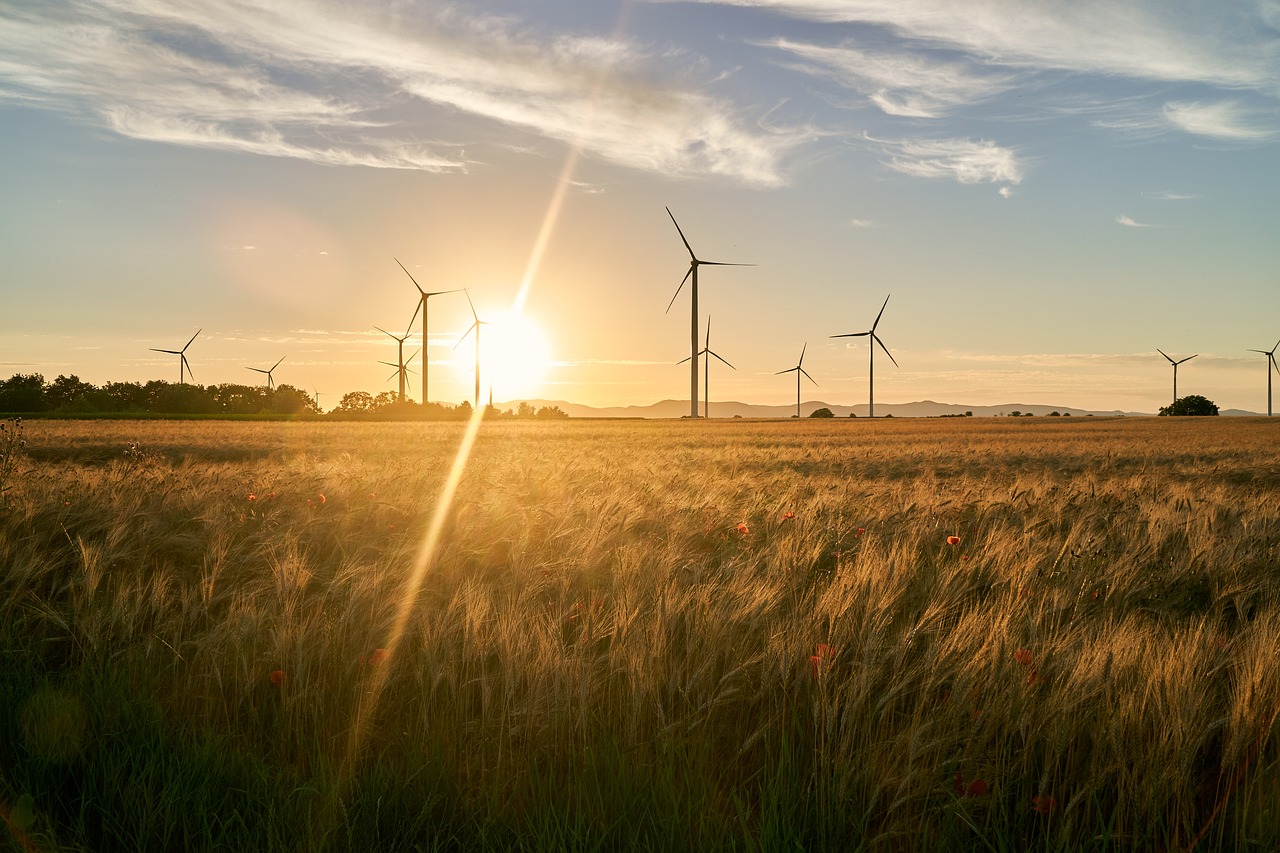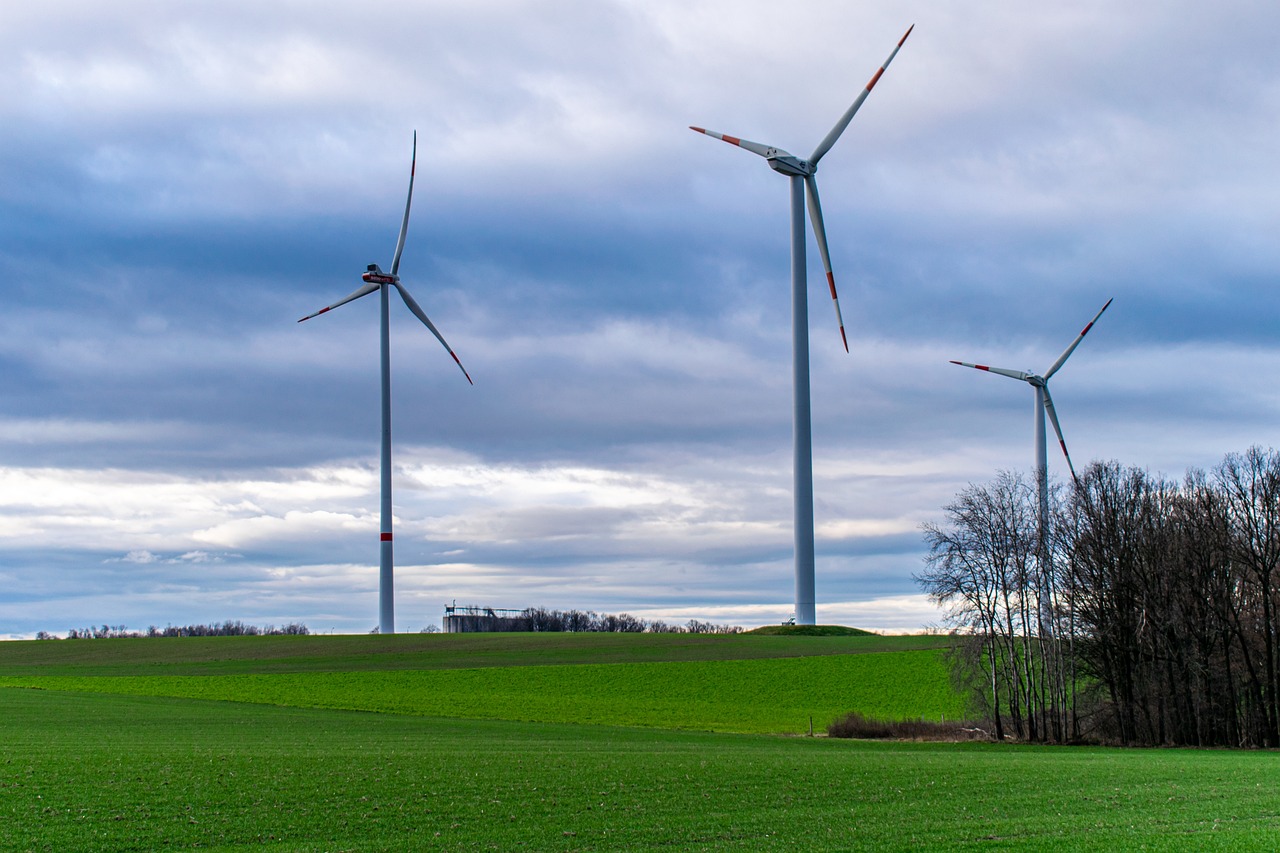Can Green Energy Solutions Aid in Poverty Reduction?
In today's world, the conversation around green energy solutions is more relevant than ever, especially when we consider their potential impact on poverty reduction. Imagine a world where every household has access to affordable, sustainable energy. Not only would this improve daily living conditions, but it would also open doors to new opportunities for economic growth and community empowerment. By harnessing the power of renewable energy sources, we can create a ripple effect that uplifts marginalized communities, fosters job creation, and enhances overall quality of life.
At the heart of this discussion lies the undeniable connection between energy access and economic development. In many impoverished regions, the lack of reliable energy sources stifles growth and innovation. Without electricity, businesses struggle to operate, students face educational hurdles, and healthcare facilities are unable to provide essential services. Green energy initiatives, such as solar, wind, and biomass, present a viable solution to bridge this energy gap. By investing in these technologies, we can pave the way for sustainable development that not only addresses energy poverty but also contributes to long-term economic stability.
Moreover, green energy projects do not just provide power; they also create jobs and stimulate local economies. As we delve deeper into the renewable energy sector, it becomes clear that various roles are emerging—from manufacturing and installation to maintenance and management. These jobs are particularly vital in impoverished areas, where employment opportunities may be scarce. By fostering a green workforce, we not only combat unemployment but also empower individuals with the skills necessary for a sustainable future.
As we explore the broader implications of green energy on poverty alleviation, it's essential to acknowledge the role of community-driven initiatives. When local populations take charge of renewable energy projects, they become active participants in their own development. This empowerment leads to self-sufficiency and improved living conditions. Successful case studies from around the globe demonstrate how communities can thrive when they harness renewable resources. These projects not only provide energy but also foster a sense of ownership and responsibility among community members.
In conclusion, the potential of green energy solutions to aid in poverty reduction is significant. By enhancing energy access, creating jobs, and empowering communities, we can lay the groundwork for a brighter, more sustainable future. As we continue to explore this vital topic, let's consider the ways in which we can contribute to this movement and support initiatives that align with the goals of economic and environmental sustainability.
- What are green energy solutions? Green energy solutions refer to renewable energy sources such as solar, wind, and hydroelectric power that are environmentally friendly and sustainable.
- How can green energy reduce poverty? By providing reliable energy access, creating jobs, and empowering communities, green energy initiatives can significantly improve living conditions and economic opportunities in impoverished areas.
- What types of jobs are available in the green energy sector? The green energy sector offers various roles, including manufacturing, installation, maintenance, and management of renewable energy systems.
- How do community-driven energy projects work? Community-driven energy projects involve local populations taking charge of renewable energy initiatives, leading to self-sufficiency and improved living conditions.
- What are the environmental benefits of green energy? Green energy solutions contribute to a healthier environment by reducing carbon emissions and promoting sustainable practices, which in turn supports economic growth.

The Link Between Energy Access and Poverty
Imagine waking up in a world where the first thing you do is fumble around in the dark, unable to find your way to a light switch. This is the reality for millions of people living in energy poverty. Access to reliable energy is not just a luxury; it’s a fundamental necessity for economic development and social well-being. When communities lack energy, they face a multitude of challenges that keep them trapped in a cycle of poverty. Without electricity, businesses struggle to operate, children can’t study after sunset, and healthcare facilities can’t provide essential services. The absence of energy access creates a barrier that hinders growth and innovation.
Green energy solutions, such as solar, wind, and hydroelectric power, have the potential to bridge this gap significantly. By harnessing renewable resources, communities can gain access to sustainable energy that is both affordable and environmentally friendly. This transformation can lead to a domino effect of positive outcomes. For instance, when families have reliable electricity, they can invest in education, improve their health, and start small businesses. It’s like giving someone a key to a locked door; once it’s opened, a world of opportunities unfolds.
Let’s break it down further. Consider the following points:
- Economic Growth: Access to energy can stimulate local economies. Businesses can operate more efficiently, leading to increased productivity and job creation.
- Education: With electricity, children can study at night, which improves their academic performance and future prospects.
- Healthcare: Medical facilities can function properly, ensuring that communities have access to necessary health services.
- Quality of Life: Reliable energy improves overall living conditions, allowing families to enjoy modern conveniences that many take for granted.
Furthermore, energy access is closely tied to various social issues, including gender equality. Women and girls often bear the brunt of energy poverty, spending hours on chores that could be completed more quickly with modern appliances. By providing energy access, we empower women, giving them the time and resources to pursue education and employment opportunities. This ripple effect can lead to healthier families and communities.
In conclusion, the link between energy access and poverty is undeniable. Green energy solutions not only provide the means to overcome energy poverty but also open doors to economic stability and improved quality of life. As we move forward, it’s crucial to recognize the importance of sustainable energy initiatives in the fight against poverty. The path to a brighter future is illuminated by the power of green energy.

Job Creation Through Renewable Energy
When we think about renewable energy, we often envision wind turbines spinning gracefully on hills or solar panels glistening under the sun. But beyond their visual appeal, these technologies are powerful engines for job creation. The renewable energy sector is rapidly expanding, and with it comes a plethora of job opportunities that can significantly uplift impoverished communities. Imagine a world where clean energy not only powers our homes but also fuels the dreams of individuals seeking stable employment. This is the promise of green energy, and it’s becoming a reality.
One of the most exciting aspects of renewable energy is its ability to create jobs across various sectors. From the manufacturing of solar panels to the installation of wind turbines, the opportunities are vast and varied. For instance, in a single solar farm, you might find roles ranging from engineers and project managers to electricians and laborers. Each of these positions plays a crucial role in bringing sustainable energy to life, and they all contribute to a more stable economy. According to recent studies, the renewable energy sector has the potential to create millions of jobs globally, particularly in regions that are economically disadvantaged.
To give you a clearer picture, here’s a breakdown of some key job categories within the renewable energy industry:
| Job Type | Description | Potential Impact on Local Economy |
|---|---|---|
| Manufacturing | Production of solar panels, wind turbines, and other renewable technologies. | Boosts local manufacturing jobs and stimulates the economy. |
| Installation | Setting up solar panels and wind turbines at various sites. | Creates immediate job opportunities for local workers. |
| Maintenance | Regular upkeep of renewable energy systems to ensure efficiency. | Provides long-term employment and skill development. |
But the benefits don’t stop there. The renewable energy sector also emphasizes the importance of training and skill development. Many organizations are stepping up to provide training programs designed to equip individuals with the skills necessary for these new jobs. These initiatives are especially crucial in areas where traditional job opportunities are scarce. By investing in education and skill-building, we are not only preparing individuals for the workforce but also fostering a culture of innovation and resilience.
Moreover, the rise of green energy can stimulate entrepreneurship opportunities within local communities. Small businesses can thrive by providing services related to renewable energy, such as installation, maintenance, or even consulting. This entrepreneurial spirit can create a ripple effect, leading to job creation in other sectors as well. For example, a local solar installation company might require additional support from electricians, marketing professionals, and administrative staff, thereby broadening the job market.
In conclusion, the renewable energy sector is not just about reducing carbon footprints; it is a powerful tool for job creation and economic empowerment. By harnessing the potential of green energy, we can help lift communities out of poverty and into a brighter, more sustainable future. The jobs created in this sector are not merely positions; they represent hope, stability, and the promise of a better quality of life for many individuals and families.
- What types of jobs are available in the renewable energy sector? There are various roles, including manufacturing, installation, maintenance, and project management.
- How does renewable energy contribute to local economies? By creating jobs and stimulating local businesses, renewable energy initiatives can significantly boost economic growth.
- Are there training programs available for those interested in renewable energy jobs? Yes, many organizations offer training programs to equip individuals with the necessary skills for employment in the green energy sector.

Types of Jobs in Green Energy
When we talk about the green energy sector, we're not just discussing a trend; we're diving into a vast ocean of opportunities that can lift communities out of poverty. The shift towards renewable energy sources like solar, wind, and hydroelectric power is creating a myriad of job opportunities that cater to various skill sets. Imagine the possibilities: from engineers designing cutting-edge solar panels to technicians ensuring they’re installed correctly and functioning efficiently. Each role plays a pivotal part in the larger picture of energy sustainability and economic stability.
One of the most exciting aspects of green energy jobs is their diversity. They range from highly skilled positions requiring advanced education to entry-level roles that provide on-the-job training. Here’s a closer look at some of the key types of jobs available in this burgeoning field:
- Engineering Roles: These positions involve designing and developing renewable energy technologies. Engineers work on everything from solar panel efficiency to wind turbine design, ensuring that these systems are both effective and sustainable.
- Installation Technicians: Skilled workers are needed to install renewable energy systems, such as solar panels and wind turbines. This role is crucial, as proper installation directly impacts the performance of the systems.
- Maintenance Workers: Once renewable energy systems are installed, they require ongoing maintenance to ensure they operate at peak efficiency. Maintenance workers are essential for troubleshooting and repairing any issues that arise.
- Project Managers: Overseeing renewable energy projects from conception to completion is no small feat. Project managers coordinate teams, manage budgets, and ensure that projects are delivered on time and within scope.
- Sales and Marketing Professionals: As the demand for green energy grows, so does the need for professionals who can effectively communicate the benefits of these technologies to consumers and businesses alike.
Furthermore, the renewable energy sector is not just about large-scale projects; it also opens doors for local entrepreneurs. Small businesses can emerge to provide services like solar panel cleaning, energy audits, and consulting. This entrepreneurial spirit not only creates jobs but also fosters economic resilience within communities.
Training and skill development are vital in this sector. Many organizations and educational institutions are stepping up to provide training programs tailored to the needs of the green energy industry. These programs equip individuals with the skills necessary to thrive in this dynamic field, ensuring that the workforce is ready and capable of meeting the demands of the future.
In essence, the job landscape in green energy is as vibrant and varied as the technologies themselves. By investing in education and training, communities can harness the potential of renewable energy to not only create jobs but also to drive sustainable economic growth and poverty reduction. As we continue to pivot towards greener solutions, the opportunities for employment will only expand, providing a brighter future for many.
Q1: What types of jobs are most in demand in the green energy sector?
A1: The demand for jobs in the green energy sector is broad, with engineering roles, installation technicians, maintenance workers, project managers, and sales professionals being among the most sought after. As the industry grows, the need for skilled workers in various capacities will continue to rise.
Q2: Do I need a specific degree to work in green energy?
A2: While many positions, especially in engineering and project management, may require specific degrees, there are also numerous entry-level roles that provide on-the-job training. Additionally, vocational training and certifications can enhance employability in this field.
Q3: How can I get involved in the green energy sector?
A3: Getting involved in the green energy sector can start with education—consider pursuing relevant courses or certifications. Volunteering for local renewable energy projects or joining community initiatives can also provide valuable experience and networking opportunities.

Training and Skill Development
In the rapidly evolving landscape of green energy, play a pivotal role in preparing individuals for the myriad of job opportunities that arise within this sector. As the demand for renewable energy solutions grows, so does the need for a skilled workforce capable of meeting this challenge. Imagine a world where individuals from impoverished backgrounds can gain access to training programs that not only enhance their skills but also provide them with the confidence to thrive in a competitive job market. This transformation is not just a dream; it's becoming a reality through various initiatives aimed at empowering communities.
One of the most effective ways to ensure that local populations are equipped for green energy jobs is through vocational training programs. These programs often focus on practical skills and knowledge that are directly applicable to the renewable energy sector, such as solar panel installation, wind turbine maintenance, and energy efficiency assessments. For example, community colleges and technical schools are increasingly offering courses tailored to these needs. By providing hands-on experience and theoretical knowledge, these institutions play a crucial role in bridging the skills gap.
Moreover, partnerships between governments, non-profit organizations, and private companies are essential in creating comprehensive training programs. These collaborations can lead to the establishment of community training centers that focus on renewable energy technologies. Such centers not only offer training but also serve as hubs for innovation and entrepreneurship. They empower individuals to harness their skills and contribute to local economies while promoting sustainable practices.
In addition to formal training programs, ongoing professional development is crucial. As technology advances, so too must the skills of the workforce. This is where continuing education comes into play. Workshops, online courses, and certification programs can help workers stay updated on the latest trends and technologies in the green energy sector. By investing in continuous learning, individuals can enhance their employability and adapt to the ever-changing job market.
Furthermore, mentoring and apprenticeship programs can provide invaluable support for those entering the renewable energy field. These initiatives allow less experienced workers to learn directly from seasoned professionals, gaining insights that can only be acquired through real-world experience. The benefits of such programs extend beyond individual growth; they foster a culture of knowledge-sharing and community support, which is essential for sustainable development.
To illustrate the impact of training and skill development in green energy, consider the following table showcasing the various types of training programs and their benefits:
| Type of Training Program | Skills Developed | Benefits |
|---|---|---|
| Solar Panel Installation | Technical installation skills, safety protocols | Increased job opportunities, energy cost savings for households |
| Wind Turbine Maintenance | Mechanical skills, troubleshooting techniques | Job stability, contribution to renewable energy production |
| Energy Efficiency Audits | Assessment techniques, energy management practices | Reduced energy consumption, enhanced sustainability |
In conclusion, training and skill development are not merely components of the green energy transition; they are the very foundation upon which sustainable job creation and economic empowerment are built. By investing in education and training, we can unlock the potential of individuals and communities, paving the way for a brighter, more sustainable future. The journey towards a greener economy is a collective effort, and every step taken in skill development brings us closer to achieving our goals.
Q: What types of jobs can I get in the green energy sector?
A: The green energy sector offers a wide range of job opportunities, including roles in solar panel installation, wind turbine maintenance, energy efficiency consulting, and research and development.
Q: How can I find training programs in my area?
A: You can find training programs through local community colleges, vocational schools, and online platforms that specialize in renewable energy education. Additionally, check with local non-profits and government agencies for resources.
Q: Are there scholarships available for green energy training?
A: Yes, many organizations offer scholarships and financial aid for individuals pursuing training in renewable energy. It's worth researching local and national programs that support education in this field.

Entrepreneurship Opportunities
In today's rapidly evolving world, green energy solutions are not just about saving the planet; they are also about creating vibrant economic opportunities for local entrepreneurs. Imagine a community where the sun shines brightly, and instead of just basking in its warmth, individuals harness that energy to power their businesses. This is the reality that green energy initiatives can create. By enabling local businesses to thrive, these solutions not only contribute to poverty reduction but also foster a spirit of innovation and resilience.
One of the most significant advantages of green energy is its ability to lower operational costs for small businesses. For instance, consider a local bakery that switches to solar power. Not only does it reduce its electricity bills, but it also gains a competitive edge by marketing its commitment to sustainability. This shift can lead to increased customer loyalty, as consumers are increasingly drawn to businesses that prioritize environmental responsibility.
Moreover, the green energy sector offers a plethora of entrepreneurial avenues. From solar panel installation to wind turbine maintenance, the possibilities are endless. Local entrepreneurs can tap into these markets by starting their own companies or partnering with established firms. For example, a community member with a background in engineering might launch a business that specializes in installing solar systems for homes and schools, creating jobs and boosting the local economy.
Additionally, the rise of green energy has spurred innovation in various sectors. Entrepreneurs are now developing cutting-edge technologies that enhance energy efficiency and sustainability. This includes creating energy storage solutions, smart grids, and eco-friendly appliances. By investing in these technologies, local businesses can not only contribute to a greener planet but also position themselves at the forefront of a booming industry.
Furthermore, community-based energy projects can empower individuals to take control of their energy needs. For example, a group of residents could collaborate to establish a community solar farm. This initiative not only provides clean energy but also generates profit for the participants, allowing them to reinvest in their businesses or community projects. Such projects exemplify how entrepreneurship can be a collective effort, leading to shared benefits and greater economic stability.
In summary, green energy solutions present a myriad of that can significantly impact local economies. By leveraging renewable resources, individuals can create sustainable businesses that not only uplift themselves but also their communities. As we continue to embrace these initiatives, the potential for economic growth and poverty alleviation becomes increasingly evident.
- How can green energy initiatives help local entrepreneurs? Green energy initiatives reduce operational costs and open new markets for businesses, allowing entrepreneurs to thrive.
- What types of businesses can benefit from green energy? Various businesses, including solar installation companies, energy-efficient product manufacturers, and eco-friendly service providers, can benefit from green energy.
- Are there any community-based examples of green energy entrepreneurship? Yes, community solar farms and local wind energy projects are excellent examples of collective entrepreneurship in the green energy sector.

Community Empowerment through Energy Projects
When it comes to lifting communities out of poverty, energy projects can be transformative. Imagine a village where the sun shines brightly, but the people remain in darkness—this is the reality for many communities lacking access to reliable energy. However, by harnessing renewable energy sources, such as solar and wind, these communities can not only light up their homes but also ignite a spark of empowerment and self-sufficiency. Community-driven energy projects can turn the tide, enabling local populations to take control of their energy needs and economic futures.
One of the most compelling aspects of these projects is the way they foster a sense of ownership among community members. When locals are involved in the planning, implementation, and maintenance of energy solutions, they develop a vested interest in their success. This engagement can lead to profound changes in the community's dynamics. For instance, in regions where renewable energy cooperatives have been established, residents often report a greater sense of community cohesion and collective purpose. They work together to not only generate energy but also to create a sustainable and resilient economic framework.
Successful case studies around the globe showcase how communities have taken charge of renewable energy initiatives. For example, in rural India, a group of women formed a cooperative to install solar panels in their village. Not only did they gain access to electricity, but they also started a small business that sells excess energy back to the grid. This initiative not only improved their living conditions but also empowered them economically, allowing them to invest in education and healthcare for their families.
Moreover, these energy projects can lead to job creation within the community. As local residents are trained to install and maintain renewable energy systems, they acquire valuable skills that can be applied in various sectors. This not only enhances their employability but also contributes to the overall economic development of the area. In essence, energy projects act as a catalyst for economic growth, providing the tools and resources needed for communities to thrive.
In summary, community empowerment through energy projects is a powerful means of combating poverty. By enabling local populations to take control of their energy resources, we not only improve their quality of life but also foster a spirit of self-reliance and resilience. The ripple effects of such initiatives can transform entire communities, leading to a brighter, more sustainable future for all.
- What are community-driven energy projects? These are initiatives led by local populations to develop and manage renewable energy resources in their area.
- How do these projects empower communities? By involving locals in decision-making and operations, these projects foster a sense of ownership and responsibility.
- Can these projects create jobs? Yes, they often lead to job creation in installation, maintenance, and management of energy systems.
- What are some examples of successful community energy projects? Examples include solar cooperatives in India and wind energy projects in various parts of Africa.

Environmental Benefits and Economic Growth
When we talk about green energy solutions, it’s not just about saving the planet; it’s also about creating a thriving economy. The relationship between environmental sustainability and economic growth is like a dance—each step influences the other. By investing in renewable energy sources, we can create a healthier environment that supports sustainable economic development. Imagine a world where clean air and water are the norm, not the exception. This is not just a dream; it’s a reality we can achieve through green energy initiatives.
One of the most significant impacts of green energy is its ability to reduce pollution. Traditional energy sources, such as coal and oil, release harmful emissions that not only damage our planet but also adversely affect public health. By shifting to renewable energy, we can significantly decrease air and water pollution. This shift leads to lower healthcare costs and improves the quality of life for communities, especially those in impoverished areas where pollution is often rampant. The benefits of cleaner air and water can be quantified in economic terms, as healthier populations are more productive and less reliant on medical care.
Moreover, green energy solutions can lead to job creation in sectors that are not only sustainable but also resilient. For instance, the solar and wind industries have seen exponential growth in recent years. According to a recent study, the renewable energy sector could create up to 24 million jobs worldwide by 2030. These jobs aren't just in installation; they span a variety of fields, including research, manufacturing, and maintenance. This diversity in employment opportunities helps stabilize local economies, particularly in regions that have historically struggled with high unemployment rates.
Another crucial aspect to consider is the reduction of energy costs. As more households adopt renewable energy technologies, such as solar panels or wind turbines, the overall demand for traditional energy sources decreases. This shift can lead to a drop in energy prices, allowing families to save money. These savings can be redirected towards other essential needs, such as education and healthcare. Imagine a family that previously struggled to pay their electricity bills now having the extra resources to invest in their children's future. This is the kind of transformative change that green energy can bring.
The relationship between green energy and economic growth is also reflected in the alignment with the United Nations' Sustainable Development Goals (SDGs). Green energy initiatives support several SDGs, including Goal 7: Affordable and Clean Energy and Goal 13: Climate Action. By investing in renewable energy, countries can work towards achieving these goals while simultaneously addressing the urgent issue of poverty. The ripple effect of these initiatives can lead to a more equitable society, where everyone has access to clean energy and the opportunities it brings.
In conclusion, the environmental benefits of green energy are profound, but they also pave the way for economic growth. By embracing renewable energy solutions, we can create a healthier planet and a more prosperous society. The synergy between environmental sustainability and economic development is not just a hopeful notion; it’s a necessary path towards a brighter future for all. Let’s harness the power of green energy and watch as it transforms our world!
- What are the main benefits of green energy? Green energy reduces pollution, lowers energy costs, creates jobs, and supports sustainable development.
- How does green energy contribute to economic growth? By creating jobs, reducing energy costs, and improving public health, green energy initiatives stimulate economic activity.
- Can green energy help reduce poverty? Yes, by providing affordable energy access and creating job opportunities, green energy can significantly alleviate poverty.
- What role do governments play in promoting green energy? Governments can implement policies, provide incentives, and invest in renewable energy projects to foster growth in this sector.

Reducing Energy Costs
Implementing green energy solutions is not just about saving the planet; it's also about saving money. Imagine a world where families can keep their lights on without worrying about skyrocketing electricity bills. Sounds great, right? By transitioning to renewable energy sources like solar, wind, and hydro, households can significantly reduce their energy costs. In many cases, these energy sources are not only sustainable but also free once installed. This means that after the initial investment, families can enjoy lower monthly expenses, which can lead to a more stable financial situation.
Let's break it down a little. Traditional energy sources often come with fluctuating prices due to market volatility, geopolitical tensions, and environmental regulations. On the other hand, green energy provides a more stable and predictable cost structure. For example, once a solar panel system is installed, the cost of sunlight is, well, free! This stability can be particularly beneficial for low-income families who often live paycheck to paycheck.
Moreover, lower energy costs can free up resources that families can redirect towards other essential needs. Instead of spending a significant portion of their income on energy bills, they can invest in education, healthcare, or even start a small business. This shift not only improves individual quality of life but can also have a ripple effect on the local economy. When families have more disposable income, they tend to spend it on local goods and services, which can help stimulate economic growth in their communities.
To illustrate the potential savings, consider the following table that compares the average annual energy costs for traditional energy sources versus renewable energy sources:
| Energy Source | Average Annual Cost | Potential Savings |
|---|---|---|
| Traditional (Coal, Natural Gas) | $1,500 | - |
| Solar Energy | $800 | $700 |
| Wind Energy | $900 | $600 |
As shown in the table, families can save a substantial amount by switching to renewable energy sources. These savings can make a significant difference in their overall financial health.
Additionally, many governments and organizations offer incentives for adopting green energy solutions, such as tax credits, rebates, and grants. These programs can help offset the initial costs of installation, making renewable energy even more accessible to low-income families. By taking advantage of these programs, households can not only reduce their energy costs but also benefit from a cleaner, healthier environment.
In conclusion, reducing energy costs through green energy solutions is a powerful tool for poverty alleviation. By making energy more affordable, families can redirect their finances towards other critical areas of their lives, ultimately leading to a more prosperous and sustainable future.
- How much can I save by switching to renewable energy?
The savings can vary based on location, energy consumption, and the type of renewable energy system installed. However, many families report savings of hundreds of dollars annually. - Are there any upfront costs associated with renewable energy?
Yes, there may be initial costs for installation, but many programs and incentives can help reduce these expenses. - What types of renewable energy are available?
The most common types include solar, wind, and hydro energy. Each has its own benefits and suitability depending on the location. - Can I still use traditional energy sources if I switch to renewable energy?
Yes, many households use a hybrid approach, utilizing both renewable and traditional energy sources for optimal efficiency.

Sustainable Development Goals and Green Energy
The concept of Sustainable Development Goals (SDGs) was established by the United Nations to create a better world for all by 2030. These 17 goals serve as a universal call to action to end poverty, protect the planet, and ensure prosperity for everyone. Among these goals, the role of green energy is pivotal, as it intersects with multiple SDGs, particularly those focused on poverty reduction, clean energy, and sustainable communities. But how exactly does green energy contribute to achieving these ambitious targets?
First and foremost, green energy solutions directly support Goal 7: Affordable and Clean Energy. By providing access to renewable energy sources like solar, wind, and hydroelectric power, communities can reduce their reliance on expensive and polluting fossil fuels. Imagine a family in a rural area that previously relied on kerosene lamps for light. With the installation of solar panels, not only do they gain access to reliable energy, but they also save money. This newfound financial freedom allows them to invest in education, healthcare, and other essential needs, effectively lifting themselves out of poverty.
Moreover, green energy initiatives align with Goal 1: No Poverty. By creating jobs in the renewable energy sector, these initiatives provide employment opportunities for individuals in impoverished communities. When people have sustainable jobs, they can support their families, invest in their local economies, and contribute to overall community development. For instance, a local solar panel installation company can hire residents, providing them with valuable skills and a steady income. This cycle of empowerment can create a ripple effect, transforming entire communities.
Additionally, green energy supports Goal 13: Climate Action. As we transition to renewable energy sources, we significantly reduce greenhouse gas emissions, which are a major driver of climate change. This not only helps to protect our planet but also safeguards the livelihoods of those who are most vulnerable to climate impacts. Communities that invest in green energy are better equipped to adapt to changing environmental conditions, ensuring their long-term sustainability and resilience.
To illustrate the connection between green energy and the SDGs, consider the following table:
| Sustainable Development Goal | How Green Energy Contributes |
|---|---|
| Goal 1: No Poverty | Creates jobs and boosts local economies. |
| Goal 7: Affordable and Clean Energy | Provides access to sustainable energy sources. |
| Goal 13: Climate Action | Reduces greenhouse gas emissions and enhances resilience. |
In summary, the integration of green energy solutions is not just a matter of environmental responsibility; it is a crucial strategy for achieving the Sustainable Development Goals. By focusing on renewable energy, we can tackle poverty head-on, empower communities, and create a sustainable future for generations to come. The journey towards a greener, more equitable world starts with us—every solar panel installed, every wind turbine erected, and every community empowered brings us one step closer to realizing these global goals.
- What are the Sustainable Development Goals? The SDGs are 17 global goals set by the United Nations to address various social, economic, and environmental challenges.
- How does green energy help reduce poverty? Green energy creates jobs, reduces energy costs, and improves access to reliable energy, all of which contribute to poverty alleviation.
- Can green energy contribute to climate action? Yes, by reducing reliance on fossil fuels, green energy solutions significantly lower greenhouse gas emissions.
- What role do communities play in green energy initiatives? Community-driven energy projects empower local populations, leading to self-sufficiency and improved living conditions.
Frequently Asked Questions
- How does green energy help reduce poverty?
Green energy solutions provide access to reliable and affordable energy, which is crucial for economic development. By enabling communities to harness renewable resources, these initiatives create jobs, empower local populations, and improve overall quality of life. Think of it as planting seeds in a garden; with the right care, those seeds can grow into a flourishing community.
- What types of jobs are created in the green energy sector?
The green energy sector is a treasure trove of job opportunities! From manufacturing solar panels to installing wind turbines, and even maintaining energy systems, there’s a wide range of roles available. Each job not only provides income but also contributes to local economies, making it a win-win for impoverished areas.
- Are there training programs available for green energy jobs?
Absolutely! Many organizations and initiatives offer training programs specifically designed to equip individuals with the skills needed for careers in green energy. These programs can range from technical training to entrepreneurship workshops, ensuring that everyone has a chance to thrive in this booming sector.
- How can green energy foster entrepreneurship?
Green energy can be a game-changer for local businesses. By providing affordable energy solutions, it allows small enterprises to reduce operational costs and innovate. Imagine a local bakery that can now use solar power to bake delicious bread at a lower cost—this not only helps the business but also the community it serves.
- What are some successful community-driven energy projects?
There are numerous inspiring case studies around the world where communities have taken charge of renewable energy initiatives. For instance, some villages have successfully implemented solar microgrids, leading to self-sufficiency and improved living conditions. These projects empower locals and create a sense of ownership and pride.
- How does green energy contribute to environmental sustainability?
Green energy solutions significantly reduce carbon emissions and environmental degradation. By utilizing renewable resources, we create a healthier planet that supports sustainable economic growth. It’s like giving Mother Earth a much-needed breath of fresh air, which in turn benefits all of us.
- Can green energy reduce household energy costs?
Yes! Implementing green energy solutions often leads to lower energy bills for households. When families spend less on energy, they can allocate those savings towards education, healthcare, and other essential needs, ultimately improving their quality of life.
- How do green energy initiatives align with the Sustainable Development Goals (SDGs)?
Green energy initiatives play a crucial role in achieving several of the United Nations' Sustainable Development Goals, particularly those related to poverty reduction, clean energy, and sustainable communities. By investing in renewable energy, we not only work towards a greener planet but also create opportunities for marginalized communities.



















